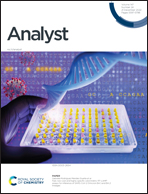A QCM immunosensor employing signal amplification strategies by enlarging the size of nanoparticles using gold or silver staining†
Abstract
We present quartz crystal microbalance (QCM) immunosensors for the detection of alpha-fetoprotein (AFP) in a human serum immunoassay with high sensitivity. In this study, we employed three types of signal amplification strategies using size enlargement and/or increase in mass of gold and titanium dioxide nanoparticles. Since the basic principle of the QCM sensor is to measure the change in resonance frequency according to the mass change caused by the molecular interactions on the sensor surface, we were able to quantitatively analyze AFP by sandwich immunoassay using gold or titanium dioxide nanoparticles conjugated with anti-AFP detection antibodies and the subsequent three signal amplification techniques in a similar manner. The signal amplification technologies provide the size expansion of gold nanoparticles by gold or silver staining reaction and mass enhancement by photocatalytic silver staining of titanium dioxide nanoparticles. The limit of detections (LODs) of the AFP immunoassay in human serum by the gold and silver staining-mediated signal amplifications for gold nanoparticles were 56 and 87 pg mL−1, respectively, but by the photocatalytic silver staining signal amplification for titanium dioxide nanoparticles was 118 pg mL−1. This means that the signal amplification method through size enhancement by gold staining of gold nanoparticles further improved the detection ability of the QCM immunosensor.



 Please wait while we load your content...
Please wait while we load your content...